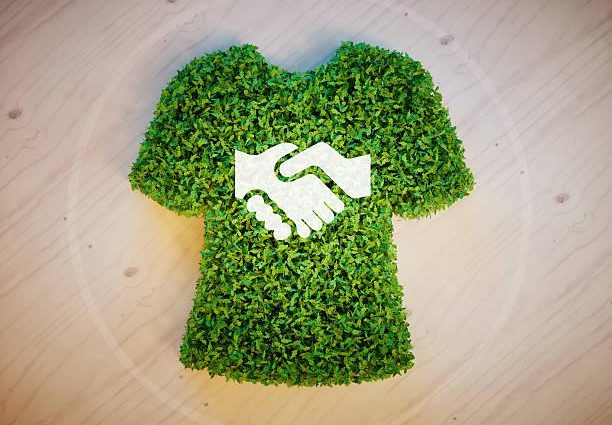Recently, when attending a Fashion and Sustainability Panel as a part of World Trade Week, I began to have feelings of anxiety about the clothes that I was wearing. In hearing the panelists speak about the transition to sustainable modes of fashion, trade, and consumption, I began to check the tags of my clothes to trace their origin. Luckily, I did not have my camera on. My shirt was thrifted but originally made in Haiti out of cotton. Pants from H&M, also cotton, made in China. The hat I was wearing from a charity bike ride was, no surprise, cotton and made in China. Guilt started to course through me as I formulated mental plans as to how to ease the karmic wrong I have wrought. Seeming to sense my silent anxiety through the screen, Prof. Andrea Reyes began to ease my worried mind with her presentation entitled “Top 5 Sustainability Myths.”
While I’m not going to go through them point by point, her main contribution to the discussion was to encourage a sense of heightened awareness about one’s own personal shopping habits as well as solidifying sustainability as both a business practice and moral lodestar. One cannot be fully sustainable, only “more sustainable.” A practice rooted in her work at the NYC Fair Trade Commission, Reyes advocated for both business and buyer accountability. While some retailers preach the superiority of naturally made products, every rule has an exception – often, if well cared for and maintained, the wear life of synthetic products can outlast cotton by years. Sustainable fashion, like healthy living, is a practice that requires vigilance. Where Prof. Reyes made this clear on a personal level, the next speaker, Elizabeth Hodur, broadened the scope of the conversation to discuss tariffs and the changing world of fashion.
The Senior Director of International Trade at Ascena, Hodur began her segment of the event by discussing the fashion trends popular one hundred years ago, like the flapper dress, noting that we are on the cusp of another such revolution. A lot has changed in a century, so the question being posed is, how do we begin to approach this sustainably? While not offering a whole solution, as it’s doubtful that any one person can, Hodur invites us to focus on the effect of tariffs on the fashion industry. Many tariffs, she notes, that were previously applicable to fashion are currently under Congressional review for reapproval (GSP, MTB, DST). This is important to understand as it has a direct effect on the wallets of the American consumer. Not only do American companies and individuals foot the bill for tariff rates, but products meant for women and girls are tariffed at higher percentages, wrenching more money from their wallets. There are ways around this. One method is tariff engineering, where a product is modified to reduce the duty rates. Elizabeth was able to teach me something about my own shoes as I was wearing Converse, whose flocked soles reduced their own rates 34.5%. This aids in sustainable goals by passing on savings to the customer and, in that way, buying opportunities for future business.
The next speaker was Dr. Hanna C. Norberg, the founder of Trade Economista, who spoke about the opportunities for transparency in trade offered by blockchain technology. In her explanation she pointed out a persistent problem in the marketing of sustainable products – there is no surefire way to know if the claims of accountability are legitimate. What blockchain seeks to do is break down the barriers that consumers have, for so long, taken for granted as inaccessible. These technologies are edging their way into the world of fashion but have currently found footing on the shelves of grocery stores. Validating food origin and processing timeline, total transparency could be instrumental in changing the way customers approach conscious consumption. If I could scan a tag and see the lineage of my meal, would that change my patterns of consumption? With the next speaker, Sara P. Schoenfeld, esq., it became clear that new trends in transparency will come with obstacles.
An attorney and CEO of The Trade Impact Foundation, Schoenfeld focused on forced labor and the potential environmental and transparency issues that could come with a more interconnected world. Her overarching point, which throws a wrench into the layman’s model of transparency, is that the supply chains that eventually spit out products are vastly complex and defy conventional modes of interpretation. When putting human rights into focus, accountability is equally difficult to monitor especially overseas. While this may be disheartening, it’s important to note, as Schoenfeld did at the end of her talk, that sustainability does not lend itself to one-and-done solutions.
“Progress not perfection.”
This panel was a part of a series organized by the NY Chapter of the Organization of Women in International Trade. The discussion on 05/27/2021 was moderated by Karen King, Founder and CEO of Fonterra Global Advisory.
—Jacob Rosen

